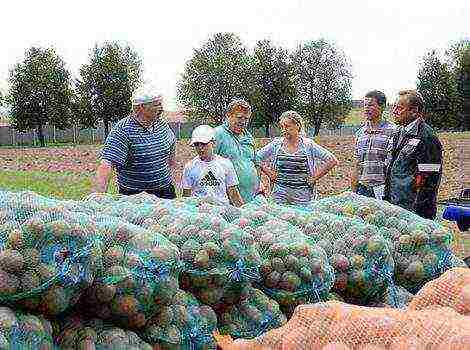Content
Traditionally, farmers have planted potatoes in holes, but a different method of planting potatoes is gaining popularity at the moment. This is the planting of tubers in the ridges. And this method has become so popular for a reason. The fact is that potatoes can be planted using this method much earlier than in the holes, since there is no need to wait until the ground warms up, because only the top layer of sod is used. And also the ridges quickly warm up in the sun, which improves the yield.
This method is very good in that it facilitates the manual disembarkation procedure itself. The ground can be prepared just before the procedure. Pour ashes onto the future bed and dig thoroughly so that the fertilizer mixes evenly.
Ridges must be spaced apart 40 centimeters... Thus, three rows will fit in a 120 cm bed. They are long mounds of earth, in which you need to place potato tubers, placing them at a distance of 30-35 cm from each other.
If the weeds can be simply pulled out, then the pests are more complicated. If there are pests on your site, such as a bear and a wireworm, then it is worth pouring poison for pests on the garden bed with fertilizer and digging it up.
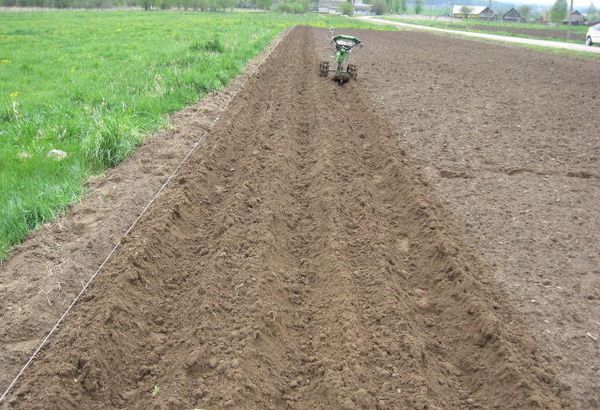
Correct cutting before planting
When the soil is fertilized and free of weeds, it is necessary to form groove ridges Location on. This can be easily done with an ordinary hoe.
On the loosened ground, draw grooves, placing them at a distance of 40-50 cm... They will be paths between the ridges. Then shape the embankment so that the ridges rise above the ground.
The higher the comb, the better. It is not worth digging the paths, thereby forming it. It is necessary to rake the top layer into the embankment, since it is already warmed up and is suitable for planting tubers.
Tuber preparation
Tubers, before planting this method, it is necessary select carefully... The potatoes should be free from cracks and medium in size.
Potatoes are considered ideal for planting by the ridge method. the size of a chicken egg... The tubers must be left in a dark place so that they germinate a little. Heavily germinated tubers are not suitable for planting with this method.
How to plant potatoes
Planting potatoes in the ridges is divided into several stages:
- Soil preparation and fertilization.
- Tuber preparation.
- Ridge formation.
- Planting potatoes.
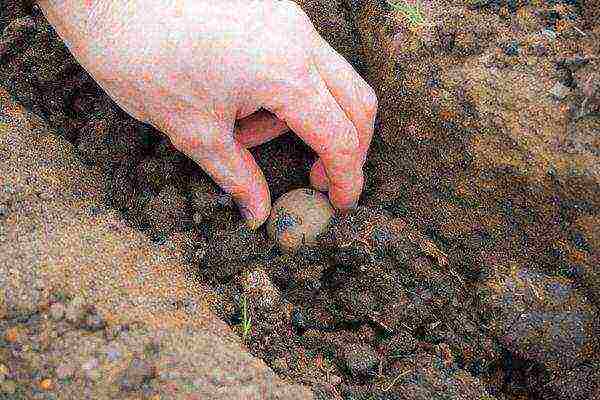
When the bed has already been formed, you can proceed directly to planting. To do this, at the top of the ridge, it is necessary to lay the tubers at a distance of 30-35 cm apart and sprinkle with earth using your hands. If the ground is dry, you can water it after the procedure.
Care
Care for the beds must be carried out in the same way as in the usual way, i.e. pull out weeds and loosen... And also, when shoots appear (20-25 days after planting) of 7-10 centimeters, the beds must be treated with a solution of potassium permanganate, taking 2 grams of substance per bucket. At the same time, you can fertilize the ridges with any liquid fertilizer.
In dry weather, the ridges need to be watered. Basically, they are watered once a month in moderate weather and twice per month in dry conditions.

And also, as soon as potato shoots appear, it is necessary to loosen the beds and sprinkle them with earth using a hoe. After rain, they must be restored with a hoe, returning them to their original appearance.
Harvesting
The crop must be harvested in the spring (late August - early September), after removing the tops from the beds 2 weeks before harvesting. This will help ripen the tubers.
Harvested potatoes must be dry and remove lumps of earth... It is necessary to store the crop in a dark and cool place. Traditionally, potatoes are kept in the cellar.
After harvesting, you need to take care of fertilizing the land for the next year. So, grass and leaves are laid between the ridges. And also often needles are laid on them. During the winter, the grass will rot, thereby fertilizing the earth.
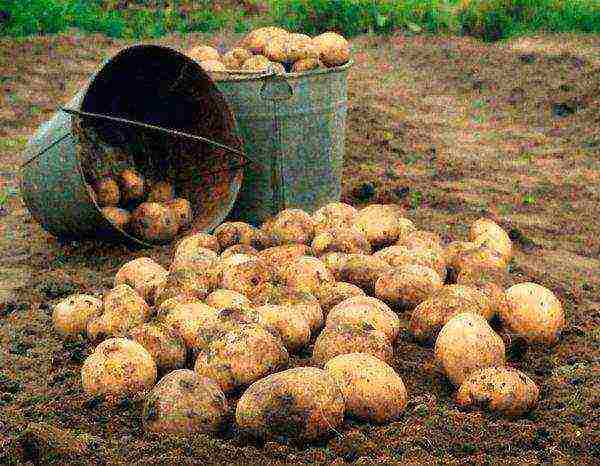
Dutch technology landing
This method gives a richer harvest than the traditional one. Its peculiarity lies in the fact that after planting, the potatoes are removed from the ridges when they have sprouted and are re-selected.
The first planting for germination of tubers is carried out very thick... Potatoes must be planted very close to each other.
Sprouted potatoes selected and re-planted in the ridges, placing the tubers at a distance of 30-35 cm from each other, sprinkling with earth. The combs should be up to 30 cm high.
Pros and cons of the method
The ridge planting method has both advantages and disadvantages.
Pros:
- High yield, compared with the traditional method of planting tubers.
- The land is less depleted, since every year you can alternate the location of ridges and paths.
- The combs warm up well, thereby improving the yield.
- This method makes it possible to penetrate oxygen to the root system, thus development is going faster.
- There is no need to huddle the beds often.
- With a large amount of precipitation, the roots of potatoes do not rot, since excess moisture rolls down the ridge; also, with a lack of moisture, the ridges restrain the required amount of water for the development of the root system.
- Thanks to ridges, snow retention improves in winter, which gives good soil moisture in spring.
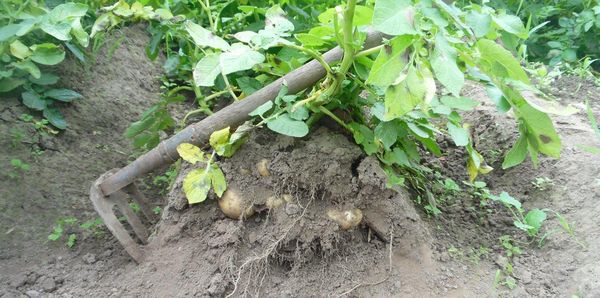
Flaws:
- Accelerated drying of the soil, which leads to constant watering and considerable waste on water.
- Not suitable for light soils, since in windy weather they crumble, exposing the tuber. Such land is rapidly becoming poorer and requires constant feeding in the form of fertilizers. Loose soil quickly gives rise to weeds and pests, which affects the yield of potatoes.
Is it possible to plant not by hand
So, using a walk-behind tractor form ridges... To do this, you need to walk along the bed with a walk-behind tractor, where the wheels passed, paths are formed, and between them directly the ridges themselves. Potatoes, after this method of forming ridges, are planted by hand.
After planting the potatoes, they are again traversed through the beds with a walk-behind tractor to cover the tubers with soil.
And they also often use hiller, since planting with this unit is less costly and easy.
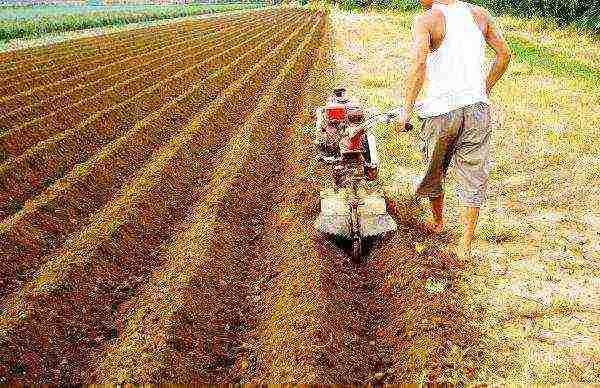
The equipment package includes such elements as:
- Furrower - for the formation of furrows;
- Conveyor - for feeding tubers;
- Distributor - forms the time intervals for the potato supply;
- Hiller - to cover the tubers with soil.
Basically, auxiliary equipment is used for a large area.
This method of planting potatoes has become very popular due to its unpretentiousness and lightness.Many farmers have been using the Dutch method for a long time, mainly to increase their yields. Of course, as with any method, it has its pros and cons. But he has much more advantages than disadvantages.


